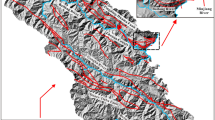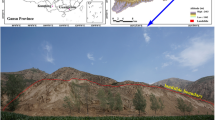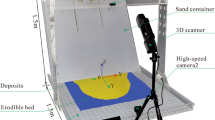Abstract
A unified and systematic understanding of the dynamic mechanism of high-speed and long-run-out landslides has not been achieved due to the fast-movement speed and long sliding distance. It is difficult to explain the evolution process using conventional dynamic methods. In this study, the evolution of the frictional heat in the sliding zone and dynamic process of the Guang'an Village landslide were studied through field investigation and MatDEM numerical simulation software. A nucleated high-heat area was formed near the sliding zone, and it expanded in the forward motion direction during the sliding. The high-heat area corresponded to the trajectory projection of the thickest part of the sliding mass. It was difficult for the heat generated by the friction in the sliding zone to dissipate during the few seconds of the sliding process, and 80% of the heat was stored in the rock and soil near the sliding zone, causing the temperature of these materials to increase sharply. The connection state diagram and heat field diagram of the MatDEM unit intuitively showed the fracture development process in the sliding mass and sliding bed. The results of this study provide an important reference for the evolution mechanism of high-speed and long-run-out landslides.












Similar content being viewed by others
References
Bao YD, Zhai SJ, Chen JP, Xu PH, Sun XH, Zhan W, Zhou X (2020) The evolution of the Samaoding paleolandslide river blocking event at the upstream reaches of the Jinsha River. Tibet Plateau Geomorphol 351:106970
Chen Z, Song DQ (2021) Numerical investigation of the recent Chenhecun landslide (Gansu, China) using the discrete element method. Nat Hazards 105:717–733
Chen Z, Ye F, Fu W, Ke Y, Hong H (2020) The infuence of DEM spatial resolution on landslide susceptibility mapping in the Baxie River basin, NW China. Nat Hazards 101:853–877
Chen Z, Zhou HF, Ye F, Liu B, Fu WX (2021) The characteristics, induced factors, and formation mechanism of the 2018 Baige landslide in Jinsha River. Southwest China Catena 203:105337
Crosta GB, Imposimato S, Roddeman D (2016) Landslide spreading, impulse water waves and modelling of the vajont rockslide. Rock Mech Rock Eng 49(6):2413–2436
De Blasio FV (2014) Friction and dynamics of rock avalanches travelling on glaciers. Geomorphology 213:88–98
Deng Y, He SM, Scaringi G, Lei XQ (2020) Mineralogical analysis of selective melting in partially coherent rockslides: bridging solid and molten friction. J Geophys Res-Sol Ea 125(8):e2022JB019453
Erismann TH (1979) Mechanisms of large landslides. Rock Mech 12:15–46
Fan XM, Xu Q, Scaringi G, Dai LX, Li WL, Dong XJ, Zhu X, Pei XJ, Dai KR, Havenith HB (2017) Failure mechanism and kinematics of the deadly June 24th 2017 Xinmo landslide, Maoxian, Sichuan. China Landslides 14(6):2129–2146
Gao Y, Li B, Gao HY, Chen LC, Wang YF (2020) Dynamic characteristics of high-elevation and long-runout landslides in the Emeishan basalt area: a case study of the Shuicheng “7.23” landslide in Guizhou. China Landslides 17:1663–1677
Habib P (1975) Production of gaseous pore pressure during rock slides. Rock Mech 7:193–197
Hampton MA, Lee HJ, Locat J (1996) Submarine landslides. Rev Geophy 34(1):33–59
Heim A (1989) Bergsturz und menschenleben. Landslides and Human Lives. Vancouver, B C: BiTech Publishers Ltd. Canada, pp 1–203
Hu M, Liu MB, Xie MW, Liu GR (2015) Three-dimensional run-out analysis and prediction of flow-like landslides using smoothed particle hydrodynamics. Environ Earth Sci 73:1629–1640
Hu W, Huang RQ, McSaveney M, Yao L, Xu Q, Feng MS, Zhang XH (2019) Superheated steam, hot CO2and dynamic recrystallization from frictional heat jointly lubricated a giant landslide: field and experimental evidence. Earth Planet Sci Lett 510:85–93
Hungr O, Evans SG (2004) Entrainment of debris in rock avalanches: an analysis of a long run-out mechanism. Geol Soc Am Bull 116(9–10):1240–1252
Hutchinson JN, Bhandari RK (1971) Untrained loading, a fundamental mechanism of mud slide and other mass movements. Géotechnique 21(4):353–358
Iverson RM (2012) Elementary theory of bed‐sediment entrainment by debris flows and avalanches. J Geophys Res-Earth, 117(F3)
Jiang MJ, Konrad JM, Leroueil S (2003) An efficient technique for generating homogeneous specimens for DEM studies. Comput Geotech 30(7):579–597
Jiang S, Ma JW, Liu ZY, Guo HX (2022) Scientometric Analysis of Artificial Intelligence (AI) for Geohazard Research. Sensors 22(20):7814
Li XF, Li HB, Xia X, Liu BB, Feng HP (2016) Numerical simulation of mechanical characteristics of jointed rock in direct shear test. Rock Soil Mech 37(2):583–591 (in Chinese)
Li K, Wang YF, Cheng QG, Lin QW, Wu Y, Long YM (2022) Insight into granular flow dynamics relying on basal stress measurements: from experimental flume tests. J Geophys Res-Earth 127(3):e2021JB022905
Liu C, Pollard DD, Shi B (2013) Analytical solutions and numerical tests of elastic and failure behaviors of close-packed lattice for brittle rocks and crystals. J Geophys Res-Solid Ea 118(1):71–82
Liu C, Pollard DD, Gu K, Shi B (2015) Mechanism of formation of wiggly compaction bands in porous sandstone: 2. numerical simulation using discrete element method. J Geophys Res-Solid Ea 120(12):8153–8168
Liu C, Xu Q, Shi B, Deng S, Zhu HH (2017) Mechanical properties and energy conversion of 3D close-packed lattice model for brittle rocks. Comput Geosci-Uk 103:12–20
Liu C, Le TC, Shi B, Zhu Y (2020) Discussion on three major problems of engineering application of the particle discrete element method. Chin J Rock Mech Eng 39(6):1142–1152 (in Chinese)
Ma JW, Xia D, Wang YK, Niu XX, Jiang S, Liu ZY, Guo HX (2022) A comprehensive comparison among metaheuristics (MHs) for geohazard modeling using machine learning: Insights from a case study of landslide displacement prediction. Eng Appl Artif Intell 114:105150
Mergili M, Frank B, Fischer JT, Huggel C, Pudasaini SP (2018) Computational experiments on the 1962 and 1970 landslide events at Huascarán (Peru) with r.avaflow: Lessons learned for predictive mass flow simulations. Geomorphology 322:15–28
Mitchell A, McDougall S, Aaron J, Brideau MA (2020) Rock avalanche-generated sediment mass flows: Definitions and hazard. Front Earth Sci 8:543937
Mora P, Place D (1993) A lattice solid model for the nonlinear dynamics of earthquakes. Int J Mod Phys C 4(6):1059–1074
Pinyol NM, Alvarado M, Alonso EE, Zabala F (2018) Thermal effects in landslide mobility. Géotechnique 68(6):528–545
Place D, Mora P (1999) The lattice solid model to simulate the physics of rocks and earthquakes: Incorporation of friction. J Comput Phys 150(2):332–372
Rui SJ, Guo Z, Wang LZ, Wang HA, Zhou WJ (2022) Inclined loading capacity of caisson anchor in South China Sea carbonate sand considering the seabed soil loss. Ocean Eng 260:111790
Rui SJ, Zhou Z, Jostad HP, Wang LZ, Guo Z (2023) Numerical prediction of potential 3-dimensional seabed trench profiles considering complex motions of mooring line. Appl Ocean Res 139:103704
Voight B, Faust C (1982) Frictional heat and strength loss in some rapid landslides. Geotechnique 32(1):43–54
Wang Y, Cheng Q, Zhu Q (2015) Surface microscopic examination of quartz grains from rock avalanche basal facies. Can Geotech J 52(2):167–181
Wang YF, Dong JJ, Cheng QG (2017) Velocity-dependent frictional weakening of large rock avalanche basal facies: Implications for rock avalanche hypermobility? J Geophys Res-Sol Ea 122(3):1648–1676
Wang YF, Dong JJ, Cheng QG (2018) Normal stress-dependent frictional weakening of large rock avalanche basal facies: Implications for the rock avalanche volume effect. J Geophys Res-Sol Ea 123(4):3270–3282
Wang LQ, Yin YP, Huang BL, Zhang ZH, Wei YJ (2019) Formation and characteristics of Guang’an Village landslide in Wuxi, Chongqing, China. Landslides 16(1):127–138
Wang YF, Lin QW, Li K (2021) Review on rock avalanche dynamics. J Earth Sci Env 43(1):164–181 (in Chinese)
Wang L, Wu CZ, Yang ZY, Wang LQ (2023a) Deep learning methods for time-dependent reliability analysis of reservoir slopes in spatially variable soils. Comput Geotech 159:105413
Wang CT, Wang H, Qin WM, Wei SA, Tian HN, Fang K (2023b) Behaviour of pile-anchor reinforced landslides under varying water level, rainfall, and thrust load: Insight from physical modelling. Eng Geol 325:107293
Xia GQ, Liu C, Xu C, Le TC (2021) Dynamic analysis of the high-speed and long-runout landslide movement process based on the discrete element method: a case study of the shuicheng landslide in guizhou, China. Adv Civ Eng 2021:1–16
Xing AG, Wang GG, Li B, Jiang Y, Feng Z, Kamai T (2015) Long-runout mechanism and landsliding behaviour of large catastrophic landslide triggered by heavy rainfall in Guanling, Guizhou. China Can Geotech J 52(7):971–981
Yang QQ, Su ZM, Cheng QG, Ren YH, Cai F (2019) High mobility of rock-ice avalanches: insights from small flume tests of gravel-ice mixtures. Eng Geol 260:105260
Yang ZJ, Liu SH, Wang LY, Liu G, Dong WF (2022) Frictional heating and thermal effects of ancient rockslide sedimentology: a case study of the Dora Kamiyama Rockslide and implications for dynamic reconstruction. B Eng Geol Environ 81(8):320
Yin YP, Zheng WM, Li XC, Sun P, Li B (2011) Catastrophic landslides associated with the M8. 0 Wenchuan earthquake. Bull Eng Geol Environ 70:15–32
Yin YP, Cheng YL, Liang JT, Wang WP (2016) Heavy-rainfall-induced catastrophic rockslide-debris flow at Sanxicun, Dujiangyan, after the Wenchuan Ms 8.0 earthquake. Landslides 13(1):9–23
Zhang M, Yin YP (2013) Dynamics, mobility-controlling factors and transport mechanisms of rapid long-runout rock avalanches in China. Eng Geol 167:37–58
Zhang WF, Huang RQ, Pei XJ (2015) Analysis on kinematics characteristics and movement process of Daguangbao landslide. J Eng Geol 23(5):866–885
Zhang YB, Xing AG, He JY, Zhang MZ, Liu YW (2023) A dynamic approach of frictional heating and thermal pressurization in landslides. Comput Geotech 154:105151
Zhao N, Yan E, Cai J (2018) A quasi two-dimensional friction-thermo-hydro-mechanical model for high-speed landslides. Eng Geol 246:198–211
Zhao NH, Zhang RT, Yan EC, He X, Liu JS (2020) A dynamic model for rapid startup of high-speed landslides based on the mechanism of friction-induced thermal pressurization considering vaporization. Landslides 17:1545–1560
Zhou JW, Cui P, Hao MH (2016) Comprehensive analyses of the initiation and entrainment processes of the 2000 Yigong catastrophic landslide in Tibet, China. Landslides 13:39–54
Zhou C, Hu YJ, Xiao T, Ou Q, Wang LQ (2023) Analytical model for reinforcement effect and load transfer of pre-stressed anchor cable with bore deviation. Constr Build Mater 379:131219
Zhu CG, Liu C, Xu Q, Hu W, Zhang XY (2019) Discrete element numerical simulation research on friction heat in sliding zone of the landslide. J Eng Geol 27(3):651–658 (in Chinese)
Zhuang Y, Xing AG, Leng YY, Bilal M, Zhang YB, Jin KP, He JY (2021) Investigation of characteristics of long runout landslides based on the multi-source data collaboration: a case study of the shuicheng basalt landslide in guizhou, China. Rock Mech Rock Eng 54:3783–3798
Acknowledgements
This study was supported by the National Natural Science Foundation of China (52308340), Sichuan Transportation Science and Technology Project (2018-ZL-01), and Special Foundation of Postdoctoral Support Program, Chongqing (2021XM3008).
Author information
Authors and Affiliations
Contributions
WZ was involved in supervision and writing—reviewing and editing. YZ and LW were involved in data curation and writing—original draft preparation. ZZ and XM were involved in conceptualization, methodology, and investigation. TX was involved in visualization and validation.
Corresponding author
Ethics declarations
Conflict of interest
The authors declare that they have no known competing financial interests or personal relationships that could have appeared to influence the work reported in this paper.
Additional information
Publisher's Note
Springer Nature remains neutral with regard to jurisdictional claims in published maps and institutional affiliations.
Rights and permissions
Springer Nature or its licensor (e.g. a society or other partner) holds exclusive rights to this article under a publishing agreement with the author(s) or other rightsholder(s); author self-archiving of the accepted manuscript version of this article is solely governed by the terms of such publishing agreement and applicable law.
About this article
Cite this article
Zhang, Y., Zhang, W., Wang, L. et al. Mechanism of the high-speed and long-run-out landslide considering the evolution of the frictional heat in the sliding zone. Nat Hazards 120, 3299–3317 (2024). https://doi.org/10.1007/s11069-023-06334-x
Received:
Accepted:
Published:
Issue Date:
DOI: https://doi.org/10.1007/s11069-023-06334-x




